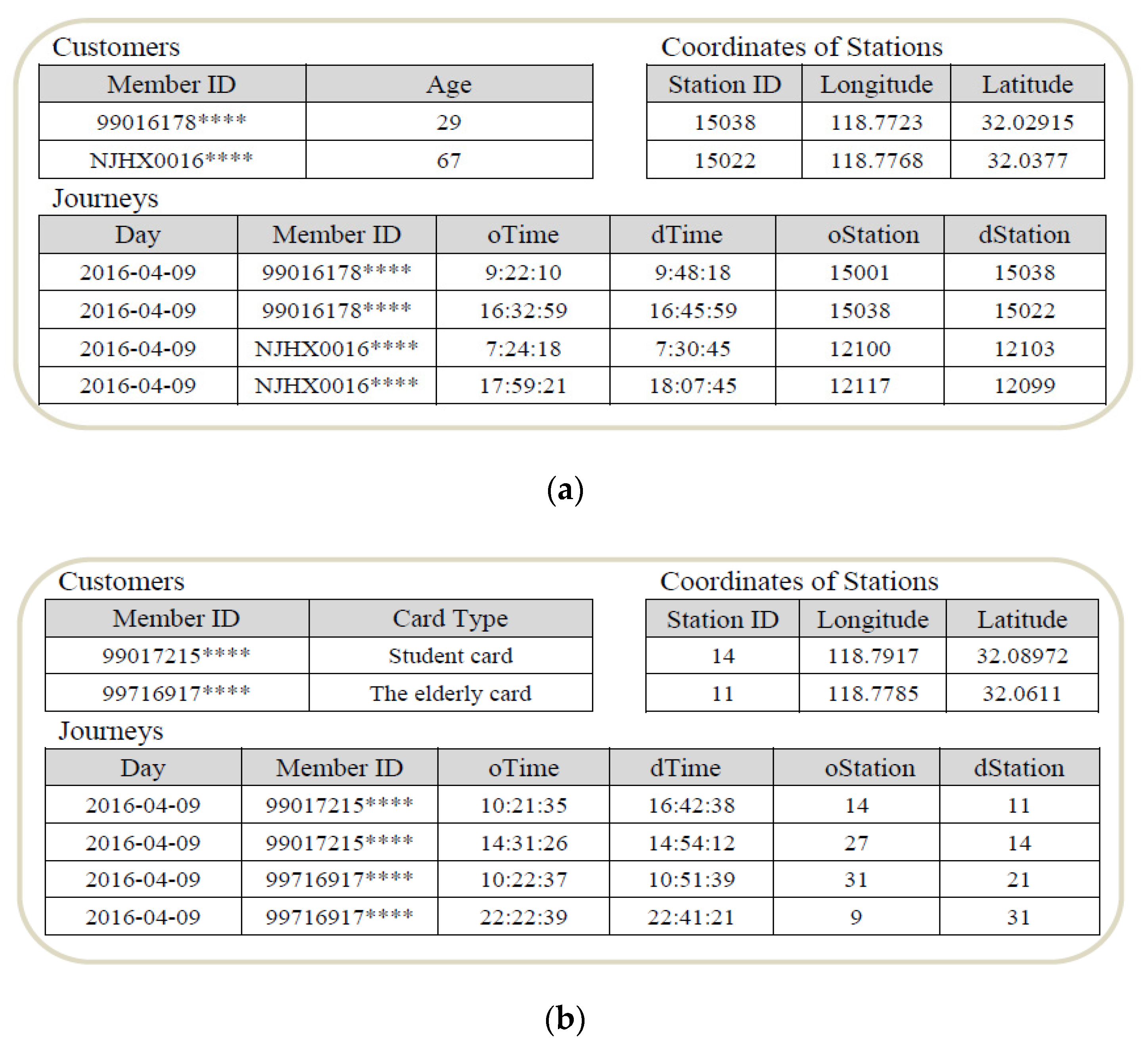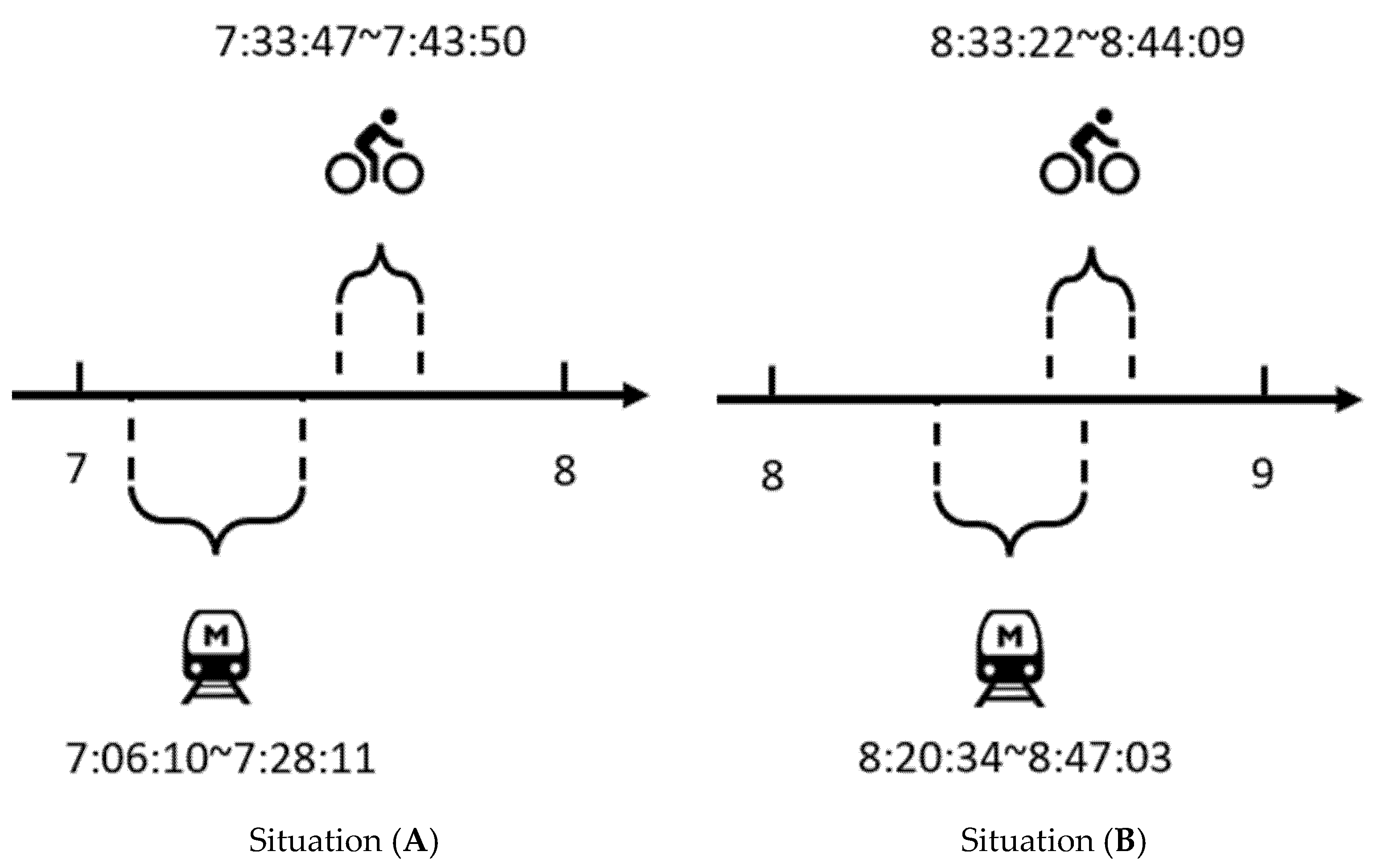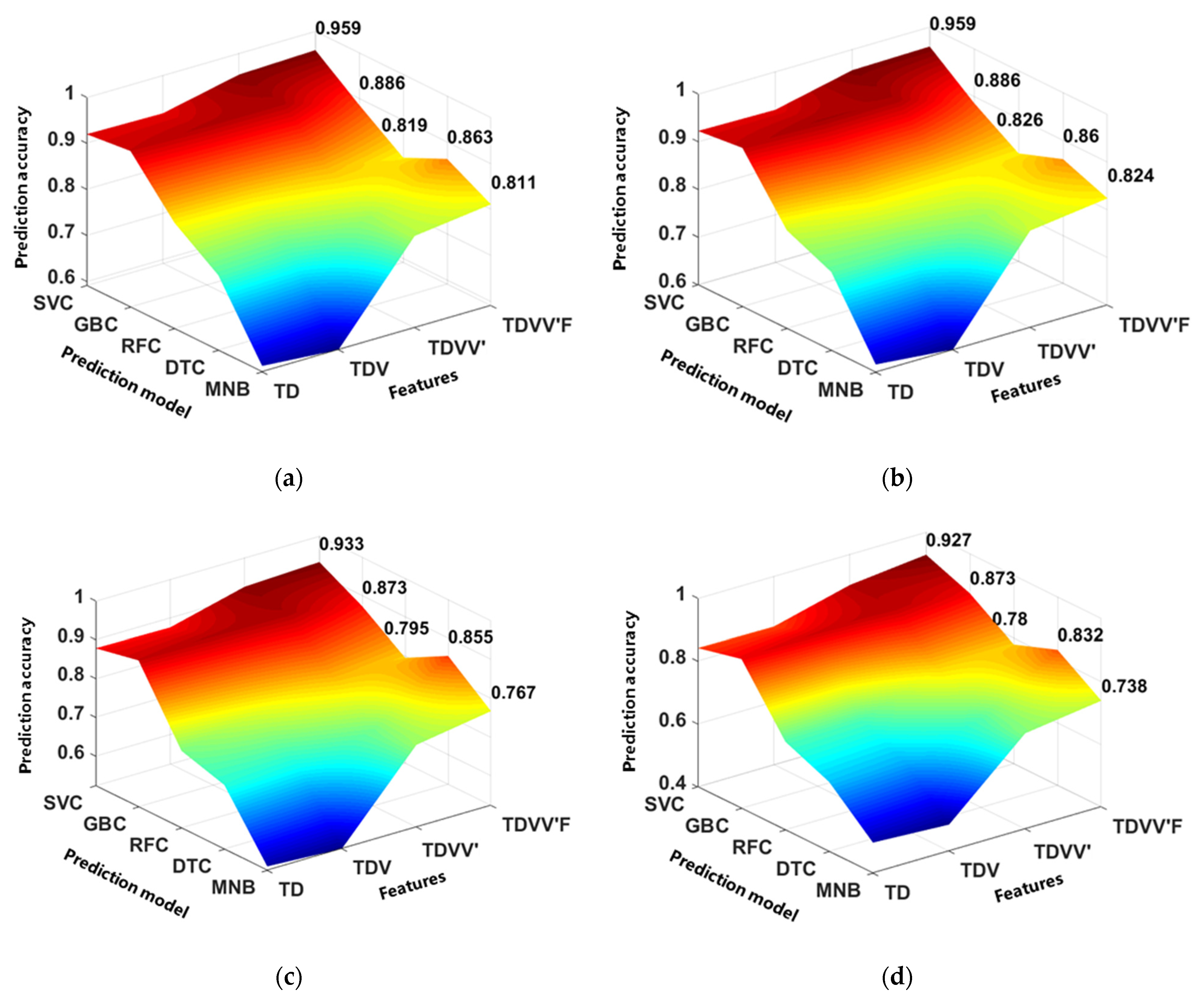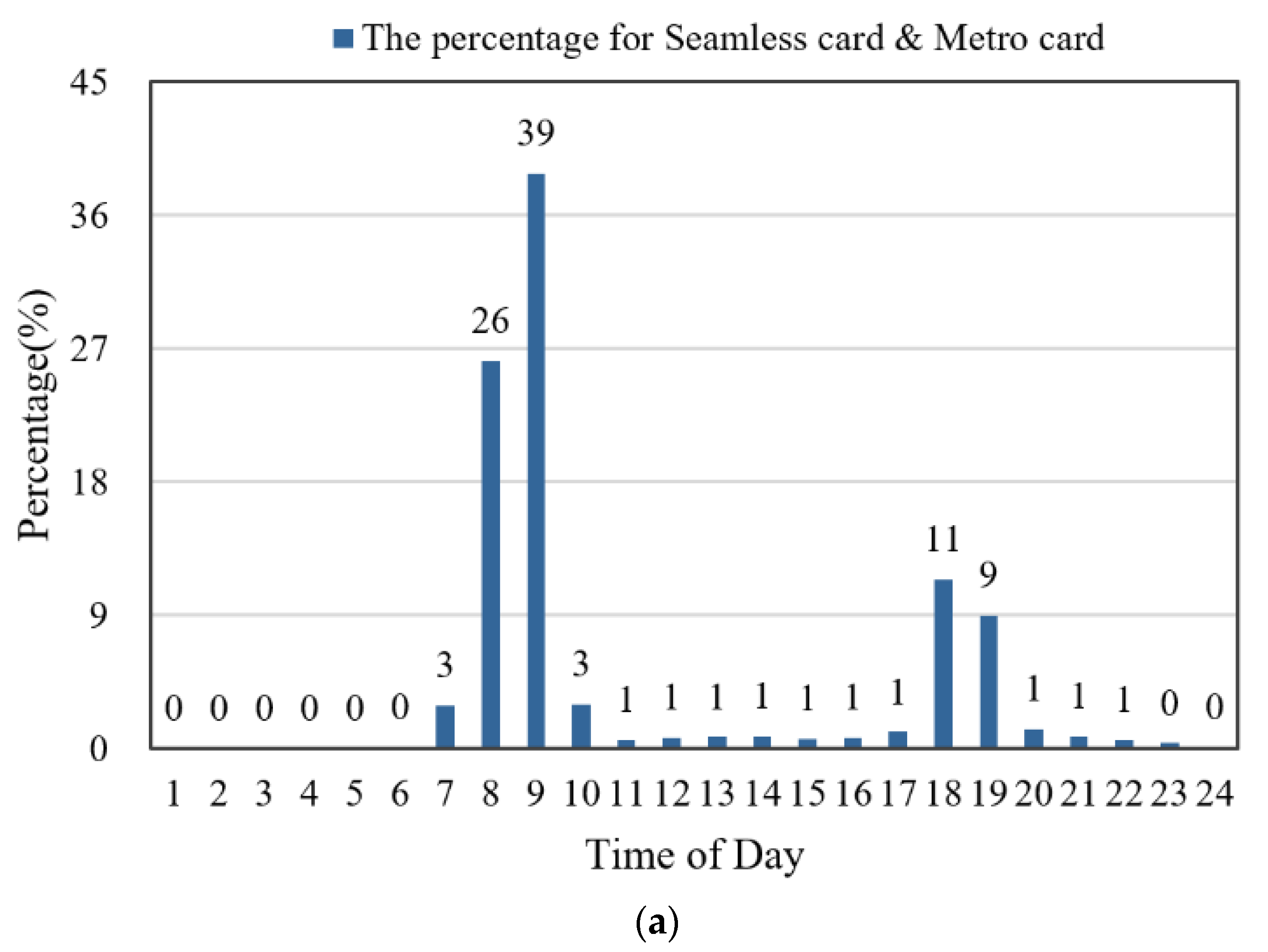Identification of Metro-Bikeshare Transfer Trip Chains by Matching Docked Bikeshare and Metro Smartcards
Abstract
:1. Introduction
2. Literature Review
2.1. Recognition of Metro–Bikeshare Transfer Trips
2.2. Usage Patterns of Metro–Bikeshare Transfer Trips
2.3. Use of Classifiers in Metro and Bikeshare Area
2.4. Research Gap
3. Methodology
3.1. Study Area and Data Source
3.2. Methodology for the Identification of Metro–Bikeshare Transfer Trips
| Algorithm 1: Generation of Metro-Bikeshare Trips | |
| Input: | card pair database call, judge value jud |
| Output: | prediction accuracy acc |
| 1 | correct_predction ← 0 # Recording the number of correct prediction |
| 2 | N ← total number of card pair |
| 2 | for i ← 1 to N do |
| 3 | x ← Average of all match records prediction value in call[i] |
| 4 | if x > jud then |
| 5 | correct_predction ← correct_predction + 1 |
| 6 | end if |
| 7 | end for |
| 8 | acc ← correct_predction / |call| |
| 9 | returnacc |
3.2.1. Generating Card Pair
- Transfer time and distance range
- Two types of transfer trip
- Card pair generation process
3.2.2. Filtering Invalid Card Pair
- Personal attribute conflict
- Temporal conflict
- Spatial conflict
- Highest Frequency
3.2.3. Valid Card Pair Identification
- Features extracting and identifier definition
- Dataset construction
- Definition: predicted identifier, card pair value and prediction value of card pair
- Model evaluation
4. Case Study
4.1. Card Pair Generation and Filter
4.2. Model Training
4.3. Model Application
5. Conclusions
Author Contributions
Funding
Conflicts of Interest
References
- Hensher, D.A. Climate change, enhanced greenhouse gas emissions and passenger transport—What can we do to make a difference? Transp. Res. Part D 2008, 13, 95–111. [Google Scholar] [CrossRef] [Green Version]
- Shelat, S.; Huisman, R.; van Oort, N. Analysing the trip and user characteristics of the combined bicycle and transit mode. Res. Transp. Econ. 2018, 69, 68–76. [Google Scholar] [CrossRef]
- Gehrke, S.R.; Russo, B.J.; Sadeghinasr, B.; Riffle, K.R.; Smaglik, E.J.; Reardon, T.G. Spatial interactions of shared e-scooter trip generation and vulnerable road user crash frequency. J. Transp. Saf. Secur. 2021, 1–17. [Google Scholar] [CrossRef]
- Meng, M.; Koh, P.P.; Wong, Y.D. Influence of socio-demography and operating streetscape on last-mile mode choice. J. Public Transp. 2016, 19, 38–54. [Google Scholar] [CrossRef]
- Pan, H.; Shen, Q.; Xue, S. Intermodal Transfer Between Bicycles and Rail Transit in Shanghai, China. Transport. Res. Rec. 2010, 2144, 181–188. [Google Scholar] [CrossRef]
- Gehrke, S.R.; Akhavan, A.; Furth, P.G.; Wang, Q.; Reardon, T.G. A cycling-focused accessibility tool to support regional bike network connectivity. Transp. Res. Part D Transp. Environ. 2020, 85, 102388. [Google Scholar] [CrossRef]
- Tilahun, N.; Thakuriah, P.V.; Li, M.; Keita, Y. Transit use and the work commute: Analyzing the role of last mile issues. J. Transp. Geogr. 2016, 54, 359–368. [Google Scholar] [CrossRef] [Green Version]
- Keijer, M.J.N.; Rietveld, P. How do people get to the railway station? The dutch experience. Transp. Plan. Technol. 2000, 23, 215–235. [Google Scholar] [CrossRef] [Green Version]
- Martin, E.W.; Shaheen, S.A. Evaluating public transit modal shift dynamics in response to bikesharing: A tale of two U.S. cities. J. Transp. Geogr. 2014, 41, 315–324. [Google Scholar] [CrossRef] [Green Version]
- Liu, L.; Sun, L.; Chen, Y.; Ma, X. Optimizing fleet size and scheduling of feeder transit services considering the influence of bike-sharing systems. J. Clean. Prod. 2019, 236, 117550. [Google Scholar] [CrossRef]
- Tavassoli, K.; Tamannaei, M. Hub network design for integrated Bike-and-Ride services: A competitive approach to reducing automobile dependence. J. Clean. Prod. 2020, 248, 119247. [Google Scholar] [CrossRef]
- Puello, L.L.P.; Geurs, K. Modelling observed and unobserved factors in cycling to railway stations: Application to transit-oriented-developments in The Netherlands. Eur. J. Transp. Infrastruct. Res. 2015, 15, 27–50. [Google Scholar]
- Fishman, E. Bikeshare: A Review of Recent Literature. Transp. Rev. 2015, 36, 92–113. [Google Scholar] [CrossRef]
- Martens, K. Promoting bike-and-ride: The Dutch experience. Transp. Res. Part A Policy Pract. 2007, 41, 326–338. [Google Scholar] [CrossRef]
- Li, W.; Joh, K. Do Residents Value the Integration of Bicycling and Transit? Assessing Their Revealed Preferences Based on Property Sale Transactions. In Proceedings of the Transportation Research Board 95th Annual Meeting, Washington, DC, USA, 10–14 January 2016. [Google Scholar]
- Jäppinen, S.; Toivonen, T.; Salonen, M. Modelling the potential effect of shared bicycles on public transport travel times in Greater Helsinki: An open data approach. Appl. Geogr. 2013, 43, 13–24. [Google Scholar] [CrossRef]
- Liu, Y.; Szeto, W.Y.; Ho, S.C. A static free-floating bike repositioning problem with multiple heterogeneous vehicles, multiple depots, and multiple visits. Transp. Res. Part C Emerg. Technol. 2018, 92, 208–242. [Google Scholar] [CrossRef]
- Sadeghinasr, B.; Akhavan, A.; Furth, P.G.; Gehrke, S.R.; Wang, Q.; Reardon, T.G. Mining dockless bikeshare data for insights into cyclist behavior and preferences: Evidence from the Boston region. Transp. Res. Part D Transp. Environ. 2021, 100, 103044. [Google Scholar] [CrossRef]
- Gehrke, S.R.; Sadeghinasr, B.; Wang, Q.; Reardon, T.G. Patterns and predictors of dockless bikeshare trip generation and duration in Boston’s suburbs. Case Stud. Transp. Policy 2021, 9, 756–766. [Google Scholar] [CrossRef]
- Zhang, Y.; Lin, D.; Mi, Z. Electric fence planning for dockless bike-sharing services. J. Clean. Prod. 2019, 206, 383–393. [Google Scholar] [CrossRef]
- Ma, X.; Ji, Y.; Yang, M.; Jin, Y.; Tan, X. Understanding bikeshare mode as a feeder to metro by isolating metro-bikeshare transfers from smart card data. Transp. Policy 2018, 71, 57–69. [Google Scholar] [CrossRef]
- Ji, Y.; Ma, X.; Yang, M.; Jin, Y.; Gao, L. Exploring Spatially Varying Influences on Metro-Bikeshare Transfer: A Geographically Weighted Poisson Regression Approach. Sustainability 2018, 10, 1526. [Google Scholar] [CrossRef] [Green Version]
- Martens, K. The bicycle as a feedering mode: Experiences from three European countries. Transp. Res. Part D Transp. Environ. 2004, 9, 281–294. [Google Scholar] [CrossRef]
- Flamm, B.J.; Rivasplata, C.R. Public Transit Catchment Areas: The Curious Case of Cycle-Transit Users. Transport. Res. Rec. 2014, 2419, 101–108. [Google Scholar] [CrossRef]
- Rietveld, P. The accessibility of railway stations: The role of the bicycle in The Netherlands. Transp. Res. Part D Transp. Environ. 2000, 5, 71–75. [Google Scholar] [CrossRef]
- Mead, D.; Johnson, M.; Rose, G. Factors Influencing Variability in the Usage of Secure Bicycle Parking at Railway Stations in Melbourne, Australia. In Proceedings of the Transportation Research Board 95th Annual Meeting, Washington, DC, USA, 10–14 January 2016. [Google Scholar]
- Caulfield, B.; Brick, E.; McCarthy, O.T. Determining bicycle infrastructure preferences—A case study of Dublin. Transp. Res. Part D Transp. Environ. 2012, 17, 413–417. [Google Scholar] [CrossRef] [Green Version]
- Ji, Y.; Fan, Y.; Ermagun, A.; Cao, X.; Wang, W.; Das, K. Public bicycle as a feeder mode to rail transit in China: The role of gender, age, income, trip purpose, and bicycle theft experience. Int. J. Sustain. Transp. 2017, 11, 308–317. [Google Scholar] [CrossRef]
- Yang, M.; Liu, X.; Wang, W.; Li, Z.; Zhao, J. Empirical Analysis of a Mode Shift to Using Public Bicycles to Access the Suburban Metro: Survey of Nanjing, China. J. Urban Plan. Dev. 2016, 142, 05015011. [Google Scholar] [CrossRef]
- Fan, A.; Chen, X.; Wan, T. How Have Travelers Changed Mode Choices for First/Last Mile Trips after the Introduction of Bicycle-Sharing Systems: An Empirical Study in Beijing, China. J. Adv. Transport. 2019, 2019, 5426080. [Google Scholar] [CrossRef] [Green Version]
- Ji, Y.; Cao, Y.; Liu, Y.; Ma, X. Analysis of temporal and spatial usage patterns of dockless bike sharing system around rail transit station area. J. Southeast Univ. (Engl. Ed.) 2019, 35, 228–235. [Google Scholar]
- Lin, D.; Zhang, Y.; Zhu, R.; Meng, L. The analysis of catchment areas of metro stations using trajectory data generated by dockless shared bikes. Sustain. Cities Soc. 2019, 49, 101598. [Google Scholar] [CrossRef]
- Li, Y.; Zhu, Z.; Guo, X. Operating Characteristics of Dockless Bike-Sharing Systems near Metro Stations: Case Study in Nanjing City, China. Sustainability 2019, 11, 2256. [Google Scholar] [CrossRef] [Green Version]
- Wu, X.; Lu, Y.; Lin, Y.; Yang, Y. Measuring the Destination Accessibility of Cycling Transfer Trips in Metro Station Areas: A Big Data Approach. Int. J. Environ. Res. Public Health 2019, 16, 2641. [Google Scholar] [CrossRef] [Green Version]
- Ni, Y.; Chen, J. Exploring the Effects of the Built Environment on Two Transfer Modes for Metros: Dockless Bike Sharing and Taxis. Sustainability 2020, 12, 2034. [Google Scholar] [CrossRef] [Green Version]
- Song, Y.; Huang, Y. Investigating Complementary and Competitive Relationships between Bikeshare Service and Public Transit: A Spatial-Temporal Framework. Transp. Res. Rec. 2020, 2674, 260–271. [Google Scholar] [CrossRef]
- Audikana, A.; Ravalet, E.; Baranger, V.; Kaufmann, V. Implementing bikesharing systems in small cities: Evidence from the Swiss experience. Transp. Policy 2017, 55, 18–28. [Google Scholar] [CrossRef]
- Bachand-Marleau, J.; Lee, B.H.Y.; El-Geneidy, A.M. Better Understanding of Factors Influencing Likelihood of Using Shared Bicycle Systems and Frequency of Use. Transport. Res. Rec. 2012, 2314, 66–71. [Google Scholar] [CrossRef] [Green Version]
- Cheng, Y.H.; Lin, Y.C. Expanding the effect of metro station service coverage by incorporating a public bicycle sharing system. Int. J. Sustain. Transp. 2018, 12, 241–252. [Google Scholar] [CrossRef]
- Noland, R.B.; Smart, M.J.; Guo, Z. Bikeshare trip generation in New York City. Transp. Res. Part A Policy Pr. 2016, 94, 164–181. [Google Scholar] [CrossRef]
- Zhao, J.; Wang, J.; Deng, W. Exploring bikesharing travel time and trip chain by gender and day of the week. Transp. Res. Part C Emerg. Technol. 2015, 58, 251–264. [Google Scholar] [CrossRef]
- Zhao, P.; Li, S. Bicycle-metro integration in a growing city: The determinants of cycling as a transfer mode in metro station areas in Beijing. Transp. Res. Part A Policy Pract. 2017, 99, 46–60. [Google Scholar] [CrossRef]
- Ma, T.; Knaap, G. Estimating the Impacts of Capital Bikeshare on Metrorail Ridership in the Washington Metropolitan Area. Transp. Res. Rec. 2019, 2673, 371–379. [Google Scholar] [CrossRef]
- Xu, D.; Bian, Y.; Rong, J.; Wang, J.; Yin, B. Study on Clustering of Free-Floating Bike-Sharing Parking Time Series in Beijing Subway Stations. Sustainability 2019, 11, 5439. [Google Scholar] [CrossRef] [Green Version]
- Xiao, G.; Juan, Z.; Gao, J. Detecting Travel Modes Using Particular Rules Combined with a Nave Bayesian Classifier. In Proceedings of the Transportation Research Board 94th Annual Meeting, Washington, DC, USA, 11–15 January 2015. No. 15-4530. [Google Scholar]
- Chin, J.; Callaghan, V.; Lam, I. Understanding and personalising smart city services using machine learning, The Internet-of-Things and Big Data. In Proceedings of the 2017 IEEE 26th International Symposium on Industrial Electronics (ISIE), Edinburgh, UK, 19–21 June 2017. [Google Scholar]
- Patalas-Maliszewska, J.; Halikowski, D. A model for generating workplace procedures using a CNN-SVM architecture. Symmetry 2019, 11, 1151. [Google Scholar] [CrossRef] [Green Version]
- Taigman, Y.; Yang, M.; Ranzato, M.A. Deepface: Closing the gap to human-level performance in face verification. In Proceedings of the IEEE conference on computer vision and pattern recognition, Columbus, OH, USA, 23–28 June 2014; pp. 1701–1708. [Google Scholar]
- Jahangiri, A.; Rakha, H. Developing a support vector machine (SVM) classifier for transportation mode identification by using mobile phone sensor data. In Proceedings of the Transportation Research Board 93rd Annual Meeting, Washington, DC, USA, 12–16 January 2014; Volume 14, p. 1442. [Google Scholar]
- Joo, S.; Oh, C.; Jeong, E.; Lee, G. Categorizing bicycling environments using GPS-based public bicycle speed data. Transp. Res. Part C Emerg. Technol. 2015, 56, 239–250. [Google Scholar] [CrossRef]
- Zhu, K.; Xun, P.; Li, W.; Li, Z.; Zhou, R. Prediction of passenger flow in urban rail transit based on big data analysis and deep learning. IEEE Access 2019, 7, 142272–142279. [Google Scholar] [CrossRef]
- Zhou, G.; Tang, J. Forecast of urban rail transit passenger flow in holidays based on support vector machine model. IEEE Access 2020, 7, 585–589. [Google Scholar]
- Wang, X.; Zhang, N.; Zhang, Y.; Shi, Z. Forecasting of short-term metro ridership with support vector machine online model. J. Adv. Transp. 2018, 2018, 3189238. [Google Scholar] [CrossRef]
- Nurviana, N.; Ati, S.K.; Hanifah, H.P. Predictive Model of Passengers Trans Metro Bandung Encouraging Smart Transportation. J. Sist. Cerdas 2019, 2, 111–118. [Google Scholar] [CrossRef]
- Cheng, L.; Chen, X.; De Vos, J.; Lai, X.; Witlox, F. Applying a random forest method approach to model travel mode choice behavior. Travel Behav. Soc. 2018, 14, 1–10. [Google Scholar] [CrossRef]
- Lin, S.; Tian, H. Short-Term Metro Passenger Flow Prediction Based on Random Forest and LSTM. In Proceedings of the 4th Information Technology, Networking, Electronic and Automation Control Conference (ITNEC), Chongqing, China, 12–14 June 2020; Volume 1, pp. 2520–2526. [Google Scholar]
- Patil, A.; Musale, K.; Rao, B.P. Bike share demand prediction using RandomForests. IJISET Int. J. Innov. Sci. Eng. Technol. 2015, 2, 1218–1223. [Google Scholar]
- Wang, B.; Kim, I. Short-term prediction for bike-sharing service using machine learning. Transp. Res. Procedia 2018, 34, 171–178. [Google Scholar] [CrossRef]
- Ruffieux, S.; Mugellini, E.; Spycher, N. Real-Time Usage Forecasting for Bike-Sharing Systems. In Proceedings of the 2017 Intelligent Systems Conference, London, UK, 7–8 September 2017. [Google Scholar]
- Datla, M.V. Bench marking of classification algorithms: Decision Trees and Random Forests-a case study using R. In Proceedings of the 2015 international conference on trends in automation, communications and computing technology (I-TACT-15), Bangalore, India, 21–22 December 2015; pp. 1–7. [Google Scholar]
- Ding, C.; Wang, D.; Ma, X.; Li, H. Predicting short-term subway ridership and prioritizing its influential factors using gradient boosting decision trees. Sustainability 2016, 8, 1100. [Google Scholar] [CrossRef] [Green Version]
- Lee, J.; Yu, K.; Kim, J. Public Bike Trip Purpose Inference Using Point-of-Interest Data. ISPRS Int. J. Geo-Inf. 2021, 10, 352. [Google Scholar] [CrossRef]
- Gan, Z.; Yang, M.; Feng, T.; Timmermans, H.J. Examining the relationship between built environment and metro ridership at station-to-station level. Transp. Res. Part D Transp. Environ. 2020, 82, 102332. [Google Scholar] [CrossRef]
- Ling, X.; Huang, Z.; Wang, C.; Zhang, F.; Wang, P. Predicting subway passenger flows under different traffic conditions. PLoS ONE 2018, 13, e0202707. [Google Scholar]
- Zhang, Z.; Ma, Y.; Chen, S.; Hu, S.; Li, Z. A Microscopic Spatial-Temporal Forecast Framework for Inflow and Outflow Gap of Free-Floating Bike Sharing System. In Proceedings of the CICTP 2020, Xi’an, China, 14–16 August 2020; pp. 4667–4679. [Google Scholar]
- Nanjing Transport Annual Report; Nanjing Planning Bureau: Nanjing, China, 2018.
- Zhao, D.; Ong, G.P.; Wang, W.; Hu, X. Effect of built environment on shared bicycle reallocation: A case study on Nanjing, China. Transp. Res. Part A Policy Pr. 2019, 128, 73–88. [Google Scholar] [CrossRef]
- Zhang, Y.; Thomas, T.; Brussel, M.; van Maarseveen, M. Exploring the impact of built environment factors on the use of public bikes at bike stations: Case study in Zhongshan, China. J. Transp. Geogr. 2017, 58, 59–70. [Google Scholar] [CrossRef]
- Imani, A.F.; Eluru, N.; El-Geneidy, A.M.; Rabbat, M.; Haq, U. How land-use and urban form impact bicycle flows: Evidence from the bicycle-sharing system (BIXI) in Montreal. J. Transp. Geogr. 2014, 41, 306–314. [Google Scholar] [CrossRef]








| Card Pair | Transfer Time (s) | Transfer Distance (m) | Transfer Speed (m/s) | Speed VAR | Frequency (Times) |
|---|---|---|---|---|---|
| Matched card pair | |||||
| 970475145994–970475145994 | 288 | 109.97 | 0.382 | 0.008 | 4 |
| 970475145994–970475145994 | 204 | 109.97 | 0.539 | 0.008 | 4 |
| 970475145994–970475145994 | 176 | 109.97 | 0.625 | 0.008 | 4 |
| 970475145994–970475145994 | 212 | 109.97 | 0.519 | 0.008 | 4 |
| Unmatched card pair | |||||
| 970071247468–990776080090 | 72 | 94.25 | 1.309 | 2.600 | 4 |
| 970071247468–990776080090 | 434 | 94.25 | 0.217 | 2.600 | 4 |
| 970071247468–990776080090 | 22 | 94.25 | 4.284 | 2.600 | 4 |
| 970071247468–990776080090 | 187 | 94.25 | 0.504 | 2.600 | 4 |
| Card Pair | Predicted Identifier | The Average of Predicted Identifier | Prediction Value of Card Pair |
|---|---|---|---|
| 993171107872–993171107872 | 1 | 0.75 (> threshold 0.6) | 1 (a valid card pair predicted as a valid one) |
| 993171107872–993171107872 | 0 | ||
| 993171107872–993171107872 | 1 | ||
| 993171107872–993171107872 | 1 | ||
| 976675052251–976675052251 | 0 | 0 (< threshold 0.6) | 0 (a valid card pair predicted as an invalid one) |
| 976675052251–976675052251 | 0 | ||
| 976675052251–976675052251 | 0 | ||
| 970071637524–996572494834 | 0 | 0.67 (> threshold 0.6) | 1 (an invalid card pair predicted as a valid one) |
| 970071637524–996572494834 | 1 | ||
| 970071637524–996572494834 | 1 | ||
| 970071637524–970074774741 | 0 | 0.33 (< threshold 0.6) | 0 (an invalid card pair predicted as an invalid one) |
| 970071637524–970074774741 | 0 | ||
| 970071637524–970074774741 | 1 |
Publisher’s Note: MDPI stays neutral with regard to jurisdictional claims in published maps and institutional affiliations. |
© 2021 by the authors. Licensee MDPI, Basel, Switzerland. This article is an open access article distributed under the terms and conditions of the Creative Commons Attribution (CC BY) license (https://creativecommons.org/licenses/by/4.0/).
Share and Cite
Ma, X.; Zhang, S.; Jin, Y.; Zhu, M.; Yuan, Y. Identification of Metro-Bikeshare Transfer Trip Chains by Matching Docked Bikeshare and Metro Smartcards. Energies 2022, 15, 203. https://doi.org/10.3390/en15010203
Ma X, Zhang S, Jin Y, Zhu M, Yuan Y. Identification of Metro-Bikeshare Transfer Trip Chains by Matching Docked Bikeshare and Metro Smartcards. Energies. 2022; 15(1):203. https://doi.org/10.3390/en15010203
Chicago/Turabian StyleMa, Xinwei, Shuai Zhang, Yuchuan Jin, Minqing Zhu, and Yufei Yuan. 2022. "Identification of Metro-Bikeshare Transfer Trip Chains by Matching Docked Bikeshare and Metro Smartcards" Energies 15, no. 1: 203. https://doi.org/10.3390/en15010203
APA StyleMa, X., Zhang, S., Jin, Y., Zhu, M., & Yuan, Y. (2022). Identification of Metro-Bikeshare Transfer Trip Chains by Matching Docked Bikeshare and Metro Smartcards. Energies, 15(1), 203. https://doi.org/10.3390/en15010203






